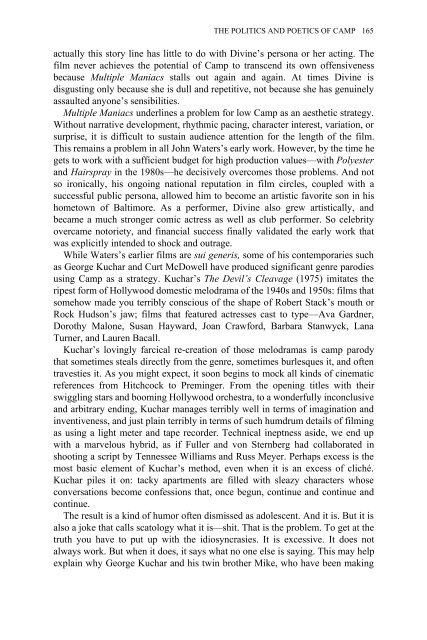Edited by Moe Meyer - Get a Free Blog
Edited by Moe Meyer - Get a Free Blog
Edited by Moe Meyer - Get a Free Blog
Create successful ePaper yourself
Turn your PDF publications into a flip-book with our unique Google optimized e-Paper software.
THE POLITICS AND POETICS OF CAMP 165<br />
actually this story line has little to do with Divine’s persona or her acting. The<br />
film never achieves the potential of Camp to transcend its own offensiveness<br />
because Multiple Maniacs stalls out again and again. At times Divine is<br />
disgusting only because she is dull and repetitive, not because she has genuinely<br />
assaulted anyone’s sensibilities.<br />
Multiple Maniacs underlines a problem for low Camp as an aesthetic strategy.<br />
Without narrative development, rhythmic pacing, character interest, variation, or<br />
surprise, it is difficult to sustain audience attention for the length of the film.<br />
This remains a problem in all John Waters’s early work. However, <strong>by</strong> the time he<br />
gets to work with a sufficient budget for high production values—with Polyester<br />
and Hairspray in the 1980s—he decisively overcomes those problems. And not<br />
so ironically, his ongoing national reputation in film circles, coupled with a<br />
successful public persona, allowed him to become an artistic favorite son in his<br />
hometown of Baltimore. As a performer, Divine also grew artistically, and<br />
became a much stronger comic actress as well as club performer. So celebrity<br />
overcame notoriety, and financial success finally validated the early work that<br />
was explicitly intended to shock and outrage.<br />
While Waters’s earlier films are sui generis, some of his contemporaries such<br />
as George Kuchar and Curt McDowell have produced significant genre parodies<br />
using Camp as a strategy. Kuchar’s The Devil’s Cleavage (1975) imitates the<br />
ripest form of Hollywood domestic melodrama of the 1940s and 1950s: films that<br />
somehow made you terribly conscious of the shape of Robert Stack’s mouth or<br />
Rock Hudson’s jaw; films that featured actresses cast to type—Ava Gardner,<br />
Dorothy Malone, Susan Hayward, Joan Crawford, Barbara Stanwyck, Lana<br />
Turner, and Lauren Bacall.<br />
Kuchar’s lovingly farcical re-creation of those melodramas is camp parody<br />
that sometimes steals directly from the genre, sometimes burlesques it, and often<br />
travesties it. As you might expect, it soon begins to mock all kinds of cinematic<br />
references from Hitchcock to Preminger. From the opening titles with their<br />
swiggling stars and booming Hollywood orchestra, to a wonderfully inconclusive<br />
and arbitrary ending, Kuchar manages terribly well in terms of imagination and<br />
inventiveness, and just plain terribly in terms of such humdrum details of filming<br />
as using a light meter and tape recorder. Technical ineptness aside, we end up<br />
with a marvelous hybrid, as if Fuller and von Sternberg had collaborated in<br />
shooting a script <strong>by</strong> Tennessee Williams and Russ <strong>Meyer</strong>. Perhaps excess is the<br />
most basic element of Kuchar’s method, even when it is an excess of cliché.<br />
Kuchar piles it on: tacky apartments are filled with sleazy characters whose<br />
conversations become confessions that, once begun, continue and continue and<br />
continue.<br />
The result is a kind of humor often dismissed as adolescent. And it is. But it is<br />
also a joke that calls scatology what it is—shit. That is the problem. To get at the<br />
truth you have to put up with the idiosyncrasies. It is excessive. It does not<br />
always work. But when it does, it says what no one else is saying. This may help<br />
explain why George Kuchar and his twin brother Mike, who have been making


